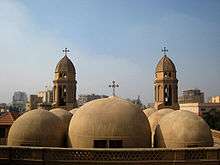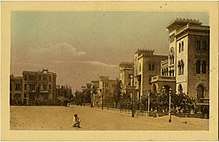Heliopolis, Cairo
Heliopolis (Egyptian Arabic: مصر الجديده, Maṣr eg-Gedīda, [ˈmɑsˤɾ eg ɡeˈdidæ], lit. "New Egypt") was a suburb outside Cairo, Egypt, which has since merged with Cairo as a district of the city and is one of the more affluent areas of Cairo. It was established in 1905 by the Heliopolis Oasis Company headed by the Belgian industrialist Édouard Empain and by Boghos Nubar, son of the Egyptian Prime Minister Nubar Pasha. It is the location of the Cairo International Airport. The population of Heliopolis is estimated at some 142,968 individuals (2016).[1]
Heliopolis Misr El Gidida | |
|---|---|
| Heliopolis | |
| Population | |
| • Total | 142,968 |

History
.jpg)


Baron Empain, a well-known amateur Egyptologist and prominent Belgian entrepreneur, arrived in Egypt in January 1904, intending to rescue one of his Belgian wife's development projects: the construction of a railway line linking Al-Matariyyah to Port Said. Despite losing the railway contract to the British, Empain stayed on in Egypt.
In 1905, Empain established the Cairo Electric Railways and Heliopolis Oases Company, which bought a large stretch of desert some distance to the northeast of Cairo at a low price from the British occupation government. His efforts culminated in 1907 with the building of the new town of Heliopolis, in the Sahara desert ten kilometers from the center of Cairo. The new city represented the first large-scale attempt to promote its own architecture, known now as the Heliopolis style. It was designed as a "city of luxury and leisure", with broad avenues and equipped with all conveniences and infrastructure: water, drains, electricity, hotel facilities, such as the Heliopolis Palace Hotel and Heliopolis House, and recreational amenities including a golf course, racetrack and park. In addition, there was housing for rent, offered in a range of innovative designs targeting specific social classes with detached and terraced villas, apartment buildings, tenement blocks with balcony access and workers' bungalows.
Baron Empain's own residence adopted a unique south Asian architectural style. Alexander Marcel, a French architect and a member of the prestigious French Institute, was commissioned by Empain to build him a Hindu style palace. Modelled on Angkor Wat in Cambodia and the Hindu temples of Orissa, the palace was erected between 1907 and 1910. It still stands today, remaining one of the finest examples of early creative use of concrete, of which it was entirely built. The neighborhood had some of the wealthiest Egyptian residences; on the left facing Avenue Baron was the Arabesque palace of Boghos and Marie Nubar Pasha, now a military headquarters. The Pasha assisted Baron Empain in purchasing the 6,000 acres (24 km²) of open desert, at one pound each, on which he built Heliopolis. Diagonally opposite stands the former residence of Sultan Hussein Kamel, who reigned over Egypt between 1914 and 1917. Today, it is a presidential guest house.
The Heliopolis War Cemetery is on Nabil el Wakkad street. This cemetery contains the Port Tewfik Memorial, a memorial to over 4000 soldiers of the British Indian Army who fell in the First World War, which was originally in Port Taufiq but was relocated to Heliopolis after its destruction in the 1970s.[2]
Modern Heliopolis was originally filled primarily with aristocratic Egyptians, as well as some European nationals. Unlike other modern Cairene suburbs around the start of the 20th century, Heliopolis had a significantly larger percentage of Egyptian citizen residents. After the 1952 revolution led by Nasser, it became home to much of Cairo's educated middle class. As Cairo has expanded, the once large distance between Heliopolis and Cairo has vanished and it is now well inside the city. Because of the large growth in population, the original gardens that filled the city have mostly been built over.
Religion
The Catholic Basilica church on Al-Ahram street is a famous landmark in Heliopolis, and it is the burial place of Baron Empain. The many places of worship in the district, including Islamic mosques, Saint Mark's Church in Cleopatra street, Saint George's church in Heliopolis Square, Christian Saint Maron (Maronite, not the St. Joseph cathedral elsewhere in Cairo) and Saint-Rita church, and the Jewish Al Missalah Street synagogue, demonstrate that the city has been living in religious tolerance since it was established. There are 16 major mosques and Islamic charities located within Heliopolis, including the Imam Hassan, Revolution, and Omar bin Abdul Aziz mosques.[3]
Since 1886, it was the seat of the Latin Catholic Apostolic Vicariate of Heliopolis (founded as Apostolic Prefecture of the Nile Delta) until its title was merged in 1987 into the Apostolic Vicariate of Alexandria in Egypt. Its Marian former Our Lady cathedral remains a Co-cathedral.
Recreational facilities

Heliopolis contains recreational places, as it was initially established to offer its residents and visitors rest and relaxation. Heliopolis club is one of the most luxurious sporting clubs in Egypt. It was established along with Heliopolis in 1905. From 1911 until 1915, Heliopolis had Luna Park, Africa's first amusement park (the grounds were converted into an Australian field hospital just after the onset of World War I).
The Merryland is also a famous recreational park; it contains a lake and was at the height of its elegance in the 1960s and 70s. It now contains a small amusement park. Other sporting clubs include El Shams Club (biggest in size and number of members), Heliolido club, El-Ghaba club, El-Tayaran club and others.
Heliopolis contains modern cafes (including Harris, Starbucks, Cilantro, Costa Coffee, and Beanos) and restaurants along with some Egyptian traditional ones. Some bars and nightclubs can be found. Tens of cinemas can be found in Heliopolis and its extension, Madinet nasr (Nasr City), Normandy Cinema in Al-Ahram street, Cinema Roxy, Cinema Heliopolis along with the new cinemas in Horia Mall and City Stars, one of the best-known shopping malls in Egypt.
Political importance
Heliopolis gained a special political and military importance in Egypt and the Middle East in recent decades. The Egyptian Military headquarters and the Egyptian Air Force headquarters are there. The Almaza Military Airbase is very close to Heliopolis. The regional headquarters of some international organizations such as the World Health Organization and the Red Crescent are in Heliopolis. Heliopolis was the residence of the Egyptian ex-president Mohamed Hosni Mubarak. In 1981, the site of Heliopolis Palace Hotel became the Egyptian Republican Palace (Arabic: قصر رئاسة الجمهورية) and the president's office.
The present and the future
In contrast with its initial establishment as a quiet suburb, Heliopolis now is considered a main part of Cairo. It is home to celebrities, football players, politicians and wealthy families. The numbers of residents have doubled several times since 1922. A tram system used to serve Heliopolis and parts of the surrounding area but it has been almost entirely closed, and partly removed, in 2015.[4] Heliopolis was already integrated into the existing underground system to link it to other pivotal residential areas all around Cairo. Several major areas of Heliopolis such as El-Ahram street, El-Marghany street and Fair Zone are already formal destinations in the newly developed Metro stations belonging to Line 3, with a plan to extend the line to include other stations such as Nozha and Cairo International Airport. The Heliopolis/Airport extensions of Line 3 are expected to be completed by the end of 2018.[5]
Notable people
- Jani Christou (1926–1970), Greek composer
- Charles Ayrout
- Henry Habib Ayrout (1907–1969)
See also
- Cairo Electric Railways and Heliopolis Oases Company
- Ancient Heliopolis
- Heliopolis style: the architectural style of Heliopolis
- New Heliopolis (suburb)
References
- "الاحياء - حي مصر الجديدة". www.cairo.gov.eg. Archived from the original on 2016-08-26. Retrieved 2017-05-17.
- http://www.cwgc.org/find-a-cemetery/cemetery/2018702/Heliopolis%20War%20Cemetery
- "مساجد مصر الجديدة - بحث Google". www.google.com.eg (in Arabic). Retrieved 2017-05-17.
- Ezzat, Amira; Ibrahim, Abeer (27 January 2016). "Good bye, Heliopolis metro". Watani International. Retrieved 2019-03-05.
- "تعرف على مشروع مترو "هارون النزهة" بمصر الجديدة وموعد إنهائه فى 8 معلومات - اليوم السابع". اليوم السابع (in Arabic). 2017-04-30. Retrieved 2017-05-17.
- "Contact Us." Lycée La Liberté Héliopolis. Retrieved on 24 January 2015. "82 El Orouba St., Heliopolis, Cairo Governorate, Egypt" Map.
Further reading
- Beattie, Andrew (2005). Cairo: A Cultural History. Oxford University Press. pp. 182–187. ISBN 0-19-517893-9.
- Dobrowolska, Agnieszka; Jaroslaw Dobrowolski (2006). Heliopolis – Rebirth of the City of the Sun. American University in Cairo Press. ISBN 977-416-008-8.
- Elsheshtawy, Yasser (2004). Planning Middle Eastern Cities: An Urban Kaleidoscope in a Globalizing World. Routledge. pp. 144–151. ISBN 0-415-30400-8.
- Once, We Hosted Kings, by Samir Raafat, Egypt Today, June 2005.
- Van Loo, Anne & Bruwier, Marie-Cécile (eds.), Héliopolis, Brussels: Fonds Mercator, 2010, 229 p., richly illustrated ISBN 978-90-6153-930-8.
External links
| Wikimedia Commons has media related to Heliopolis. |
